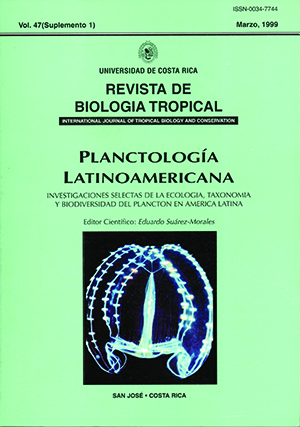Abstract
Variations in physical and chemical parameters and plankton community structure from urban-based scwage stabilization ponds in Delhi (India) were recorded from summer lo winter months of 1992-1993. The quantified physico-chemical variables were temperature, pH, dissolved oxygen, soluble reactive phosphorus, lotal phosphorus, nitrate-nitrogen and chlorophyll-a. A qualitative analysis of the phytoplankton in all the ponds was made. Among zooplankton, rotifers, cladocerans, and copepods were identífied and quantified. Observations were taken every month concentrations of soluble reactive phosphorus, total phosphorus and nitrate-nitrogen ranged between 1.2-2.0 mg l-1, 2.0-3.5 mg l-1, and 0.075-0.30 mg l-1, respectively. Although there were no significant differences in the nutrient concentrations between any of the ponlis, the ponds receiving the raw sewage first had undetectable levels of chlorophyll-a for a greater part ofthe sampling period, As the water passedthrough the series of ponds, the quality improved and finally supported high zooplankton densities. There were summer blooms of Euglena, Pandorina, Spirulina and Oscillatoria. The commonly found rotifer species were Branchionus calyciflorus, Hexarthra mira and Filinia longiseta. Cladocera and Copepoda were represented, almost exclusively, by Moina macrocopa and Mesocyclops thermocyclopoides respectively.References
APHA (American Public Health Association, American Water Works Association and Water Pollution Control Federation). 1989. Standard methods for the
exami1;lation of water and waste water; 17th ed APHA Washington D.C. 1197 p.
Curds c.R., & G. J. Fey. 1969. The effect of ciliated protozoa on the fate of Escherichia coli in the activated sludge process. Water Res. 3: 853-867.
Edmondson, WT. (ed.). 1959. Freshwater Biology 2nd ed. John Wiley and Sons, Inc., London, 1248 p.
Gilbert, U. 1988. Supression of rotifer populations by Daphnia: A review.of the evidence, the mechanisms and the effect on zooplankton community structure. Limnol. Oceanogr. 33: 1286-1303.
Green, J.; & O.B. Lan. 1974. Asplanchna and the spines of Btachionus calyciflorus in two Javanese sewage ponds. Freshwat. Biol. 4: 223-226.
Haney, J.F 1987. Field studies on zooplankton-cyanobacteria interactions. N. Z. J. Mar. Freshwat. Res. 21: 467-475.
Koste, W. 1978. Rotatoria. Die Radertiere Mitteleuropas. Ein Bestimmungswerk begrundet von Max Voigt. - Borntrager, Stuttgart. Vol. 1: Textband 673 p., Vol. 2: Tafelband 234 p.
Leonardson, L., & W. Ripl. 1980. Control of undesirable algae and induction of algal successions in hypertrophic lake ecosystems. pp 57-65. In: Barica, I, and Mur, L.R., (eds.) Hypertrophic ecosystems. Developments in Hydrobiology, Vol. 2. Junk Publishers, The Netherlands.
Madoni, P. 1991. Role of protozoans and their indicator value in the activated sludge process. pp 21-27. In: P. Madoni (ed.) Biological approach to sewage treatment process: Current status and perspectives, Perugia.
Michael, R.G., & B.K. Sharma. 1988. Fauna of India and adjacent countries (Indian Cladocera). Zoological Survey of India, Calcutta, 262 pp.
Prescott, G.W. 1951. Algae of the Western Great Lakes Area. Cranbrook Institute of Science, Michigan, 946 pp.
Rivera, F., A. Lugo, J. Ponce, F. Lares & R. Ortiz. 1986. Zooflagellates in an anaerobic waste stabilization pond system in Mexico. Water, Air, Soil Pollut 27: 199-214.
Rivera, F., M. R. Sánchez, A. Lugo, P. Ramírez, R. Ortiz & A. Calderón. 1987. Ciliates in a waste stabilization pond system in Mexico. Water, Air, Soil Pollut. 34: 245-262.
Sehgal, K.L. 1983. Planktonic copepods of freshwater ecosystems. Interprint, New Delhi, India. 169pp.
Sevrin-Reyssac, J, & M. Pletikosic. 1990. Cyanobacteria in fish ponds. Aquaculture 88: 1-20.
Sreenivasan, A. 1980. Fish production in some hypertrophic ecosystems in South India. pp 271-277. In: Barica, J., and M ur, L .R., (eds.) Hypertrophic ecosystems. Developments in Hydrobiology, Vol. 2. Junk Publishers, The Netherlands.
Starkweather, PL., J.J., Gilbert & T. M. Frost. 1979. Bacterial feeding by the rotifer Brachionus calyciflorus: Clearance rates, behaviour and population
dynamics. Oecologia 44: 26-30.
Taylor, E.W. 1958. The examination of water and water supplies. J and A. Churchill Ltd., London, 841p.
Uhlmann, D. 1980. Stability and multiple steady states of hypereutrophic ecosystems. pp. 235-247. In Barica, J., and Mur, L.R. (eds.) Hypertrophic ecosystems. Developments in Hydrobiology, Vol. 2. Junk Publishers, The Netherlands.
Vaqué D., & M. L. Pace. 1992. Grazing on bacteria by flagellates and cladocerans in lakes of contrasting food web structure. J. Plankton. Res. 14: 307-321.
Wood, L.W. 1985. Chloroform-methanol extraction of chlorophyll-a. Can. J. Fish. Aquat. Sci. 42: 38-43.
##plugins.facebook.comentarios##

This work is licensed under a Creative Commons Attribution 4.0 International License.
Copyright (c) 1999 Revista de Biología Tropical


